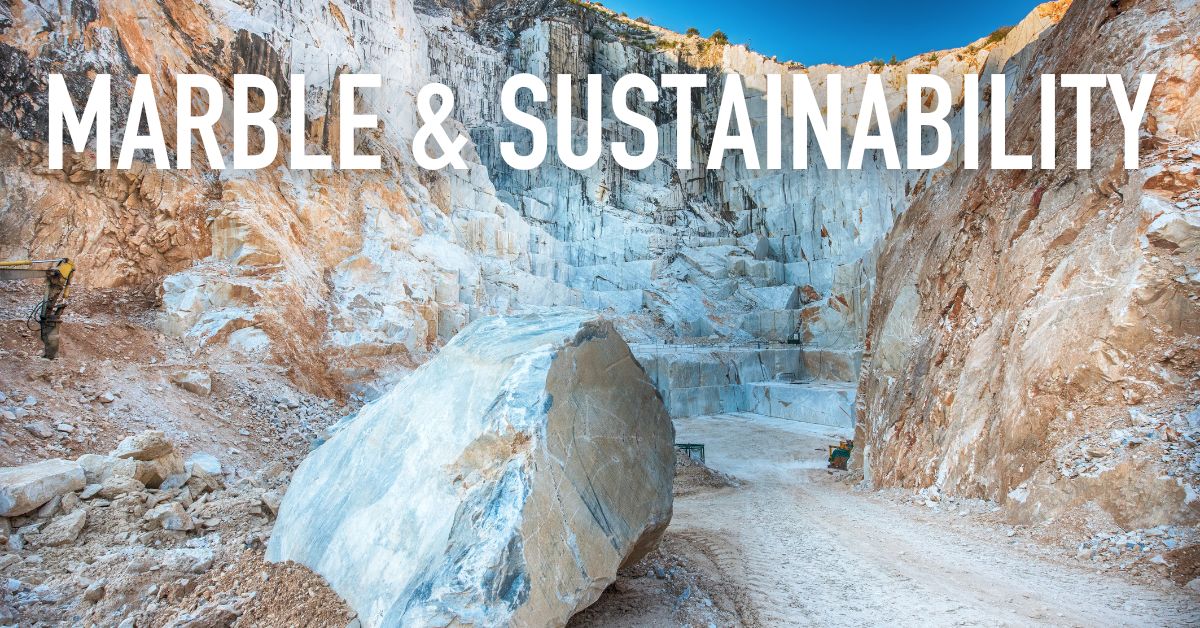Marble and sustainability: is it possible to respect the environment by choosing natural stones?

The marble industry has always been concerned about the environmental issues associated with extracting and working natural stones. In recent years, however, both operators and consumers have become more and more aware of the importance of sustainability and of the ecological aspect of the industry. Join us to discover the practices companies are adopting to reduce their impact and achieve the winning combination of marble and sustainability.
Marble, a naturally sustainable material…
Marble and natural stone are, by definition, sustainable building materials. They come directly from the earth and can be extracted from quarries all over the world. It is nature itself that is responsible for its creation, without the use of other human resources. One of its main characteristics is its exceptional durability and longevity, which makes it easy to repair or recycle: in fact, large slabs can be reworked into smaller pieces, which in turn can be cut into smaller accessories for the home once their primary function is over. Finally, marble can be ground and used in new mixes at the end of its life cycle.
… but difficult to use in a conscious way!
Marble’s ecological appeal is strong, but so is the environmental impact of the industry. Between 30% and 70% of the raw material is often transformed into waste and refuse during the extraction of the blocks and the cutting and processing of the slabs, which consumes large amounts of energy and water. In addition, some marbles are only found in certain geographical areas. To transport them around the world, a logistical network of transport and shipping is required, which consumes a lot of fuel.
Marble and sustainability: what paradigm to embrace?
In order to promote a sustainable marble industry, companies must therefore take the environment into account at every stage of the process. The ultimate goal is to preserve and hand down a precious asset – like nature – that belongs to the community. Concrete measures that can be adopted include: the reduction of emissions, the use of renewable energy sources in the quarry and in the company, the use of electric vehicles for extraction, but also the management of work in the quarry with excavation equipment that allows the minimum extraction of material.

Innovation helps sustainability
So how can marble and sustainability go hand in hand? Surely by adopting as a good entrepreneurial norm a willingness to innovate and modernize. For example, quarrying techniques have become less invasive over time. Gone are the open-cast mines that cause massive damage to surrounding ecosystems and disrupt the landscape. It is now possible to be much more precise in the cutting phases, significantly reducing waste and impact on the land, with the diamond wire mining method.
This is complemented by a more conscious use of resources, which are recycled and reintroduced into the production cycle. Water consumption, for example, is optimised, and quarry by-products find new uses in various stages of processing.
The use of natural and biodegradable glues and resins instead of harmful chemical products is becoming more and more common, as they are more sustainable and preserve the aesthetic and technical characteristics of the marble.
Another step towards more conscious management is the possibility, for the enterprises, of equipping themselves with solutions for self-production of energy. Photovoltaic technology, which converts solar energy into electricity to power the various machines involved in the extraction, cutting and polishing of marble, is an important ally in this context.
Digital tools are essential for managing all these variables and technologies. They can help optimise production schedules, track emissions and even monitor the transport process, enabling companies to make data-driven decisions that support their sustainable mission.

If you liked this article, please leave a comment.
To discover our commitment to sustainability, please visit the ‘Green Soul‘ page.


No Comments